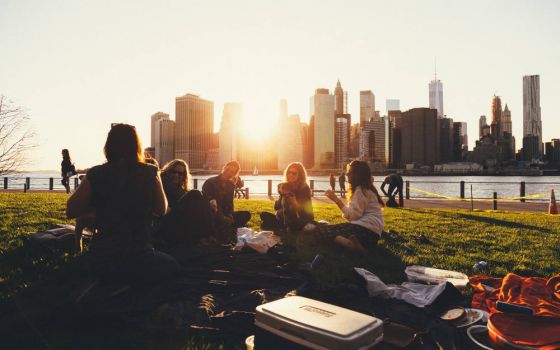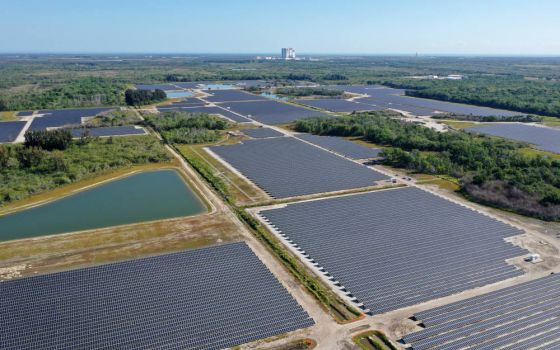First responders in Mamaroneck, New York, pull local residents in a boat Sept. 2, as they rescue people trapped by floodwaters after the remnants of Tropical Storm Ida swept through the area. (CNS photo/Mike Segar, Reuters)
Editor's Note: EarthBeat Weekly is your weekly newsletter about faith and climate change. Below is the Sept. 3 edition. To receive EarthBeat Weekly in your inbox, sign up here.
With wildfires blazing in the western United States and Canada and a hurricane that caused destruction not only along the Gulf Coast but as far away as New York City, the first days of this year's Season of Creation have made the global climate emergency virtually impossible to ignore.
The aftermath of Hurricane Ida has also shown how quickly aging urban infrastructure — like storm sewer systems designed for conditions that existed a century ago — can be overwhelmed by the increasingly severe weather that scientists predict as a result of global warming.
The convergence of extreme weather and the coronavirus pandemic make this Season of Creation, which began Sept. 1 and continues through Oct. 4, a particularly good time to reflect on ways in which we, as individuals and members of faith communities, can help restore our common home.
In a seeming geographic contradiction, the western U.S. is suffering from drought and heat waves that are exacerbating wildfires, while in the Northeast, record-breaking precipitation fell on soil already soaked from recent rains, intensifying flooding.
In California, where just the three largest fires have burned an area roughly the size of Delaware and are still largely out of control, the U.S. Forest Service closed all national forests to reduce the risk of harm to people and lessen the chance of new blazes starting. And in Minnesota, officials temporarily put the Boundary Waters Canoe Area Wilderness off limits to visitors, though they later lifted restrictions except near wildfires.
To the north, in Canada, an interactive wildfire information map shows scores of fires at various stages of control. Many of the hotspots are in British Columbia, but dozens also blaze across the central part of the country and as far east as Ontario.
Meanwhile, Hurricane Ida battered the Louisiana coast, making landfall as a Category 4 hurricane and then moving inland. As it moved inland, it was downgraded from hurricane status, then headed northeast, spawning tornadoes and record-setting downpours and leaving deadly flooding in its wake. At least 48 people died in the Northeast, including some who were trapped in ground-floor apartments or basements where water rose to the ceiling. As of midday Sept. 3, Ida's overall death toll was 61 people in eight states.
It may look like mixed signals, but the combination of drastic drought and severe storms is a pattern that has been emerging over time and is consistent with predictions for a warming world.
Advertisement
According to the U.S. government's Fourth National Climate Assessment, issued in November 2018, the average annual temperature over the lower 48 states has increased by 1.8 degrees Fahrenheit since 1900, with most of that warming occurring in the last few decades. The report forecasts an additional rise of about 2.5 F in the coming decades, regardless of efforts to reduce greenhouse gas emissions.
That means fewer days with temperatures below freezing, as well as more heat waves and days with temperatures above 90 F, the report says.
There has also been an average increase in rainfall across the country since 1900, but the effects vary from region to region, with more precipitation in the Northeast and Midwest and less in the Southwest. That trend is likely to continue, along with a tendency toward more frequent and intense heavy rains, because warmer air can hold more moisture.
The severity of flooding, of course, depends not only on the intensity of the rainfall but also on human factors, such as where we choose to build our dwellings, how much land we pave, how much buffering wetland we destroy and how well we manage water. And ultimately, it depends on whether we can make the hard choices that will stop the global temperature rise.
Disaster-management experts repeatedly say we shouldn’t talk about "natural" disasters. The weather is natural, they say, but the degree of disaster is often determined by choices made by humans. This week's disasters sound an alarm as we begin the Season of Creation, which calls us to renew the oikos, or home, of God.
Here's what's new on EarthBeat this week:
- Hurricane Ida figures prominently, as millions of people struggle to recover from the storm. Catholic dioceses in Louisiana closed schools, some until after Labor Day, and diocesan social services mobilized in the South to assess damage and provide assistance to those affected, reports Rhina Guidos at Catholic News Service.
- In Louisiana's "Cancer Alley," the hurricane piled additional hardship on communities already suffering disproportionately from COVID-19 and chronic pollution, write Julie Dermansky and Sharon Kelly at DeSmog, a member of the Covering Climate Now consortium. Among those affected was Sharon Lavigne, who recently received the Goldman Prize for her leadership of the fight against industrial contamination in St. James Parish.
- NCR environment correspondent Brian Roewe reports that Pope Francis, in a video released at the start of the Season of Creation, urged people to live in a way that is simpler and more respectful of the environment, and especially to draw inspiration from young people who are committed to caring for the Earth "because they are committed to their own future."
- Many young people have in turn drawn inspiration from Francis and his 2015 encyclical "Laudato Si', on Care for Our Common Home," writes Dennis Sadowski at Catholic News Service, who describes the journeys of various young adult Catholics whose climate advocacy stems from a deeper understanding of the integral connection between people and the Earth.
- Philip Sakimoto, who helps college students draw those connections in the sustainability minor program that he heads at the University of Notre Dame, says the church has a "profound" role to play in addressing the climate crisis, writes Catherine M. Odell. Her profile of Sakimoto includes some suggestions from the astrophysicist and former NASA official about practical steps individuals can take.
- During this Season of Creation, Brenna Davis and Michael Downs of the Ignatian Solidarity Network remind us that for people of faith, prayerful reflection provides nourishment and courage to work for environmental justice. In the first reflection of EarthBeat’s "At Home in Creation" series for this season, Davis invites each of us to revisit the place where we feel "the caress of God," and where we draw sustenance for the work to be done. And in the second, Downs reminds us that amid the disruption caused by climate change and a global pandemic, gratitude can be a grounding force.
Here's some of what's new in other climate news:
- In a first-of-its-kind report, the U.S. Environmental Protection Agency found that the country's racial minorities stand to bear the brunt of climate change, with Black people 40% more likely to live in places where extreme temperatures will lead to higher mortality rates. Darryl Fears and Dino Grandoni have the story for The Washington Post.
- The heightened risks posed by the combination of climate change and the coronavirus pandemic point to the need for policy solutions that address multiple crises at once, writes Melody Schreiber at The New Republic.
- U.S. climate envoy John Kerry was in China this week, reports David Stanway of Reuters, where he urged leaders there to do more to curtail greenhouse gas emissions and reach for the "highest ambition" ahead of the COP26 United Nations climate summit in November.
- Georgina Gustin at Inside Climate News reports on a study that found that fire and deforestation have damaged the habitat of as many as two-thirds of Amazonian species, including as many as 85% of those listed as threatened by the International Union for the Conservation of Nature.
- And in Argentina, a wealthy gated community built in a drained area that was once wetland is in turn being invaded by capybara — the world's largest rodents — that live in the surrounding ecosystem, reports Gabriela Miranda at USA Today.
Upcoming events:
The ninth International Conference on Sustainable Development, originally set to be held in Rome Sept. 8 and 9, has gone online. Presentations on those two days will focus on environmental, economic and socio-cultural sustainability.
You can find more information about this and other upcoming events on the EarthBeat Events page. And if your parish or faith group is scheduling an event, you can add it here.
Closing beat:
EarthBeat's "At Home in Creation" reflection series will continue through Oct. 4. If you haven't signed up to receive the reflections every Monday, Wednesday and Friday, you can do so here. If you also subscribe to EarthBeat Weekly, you’ll get a double reminder about the series on days when the reflection is the lead story on the EarthBeat web page.
How is your parish or faith group celebrating the Season of Creation? Tell us about it in 150 words or less in a Small Earth Story or drop us a line at earthbeat@ncronline.com and let us know.
If you enjoy EarthBeat, please spread the word — you can pass along the link to EarthBeat Weekly or suggest to friends that they sign up here to receive this newsletter every Friday in their inbox. Thank you for reading EarthBeat!






